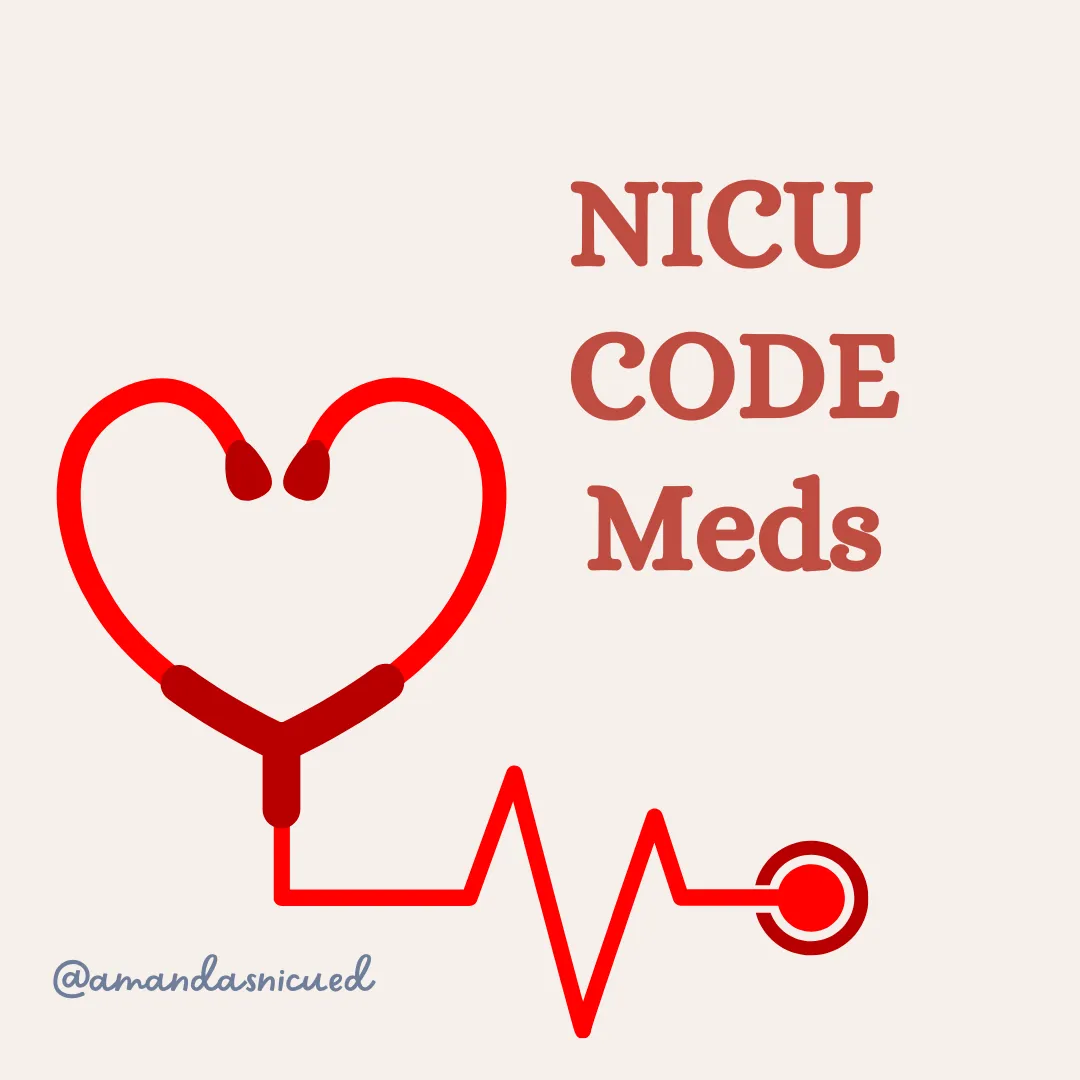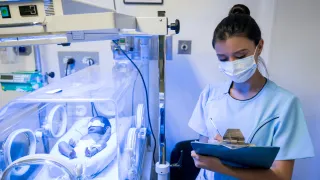
Welcome to Amanda's NICU Education




Hi! My name is Amanda. I'm a NICU nurse, Clinical Nurse Specialist, NICU Educator... basically your NICU BFF. If you want to talk NICU, I'm here for you! I love everything about NICU nursing and I'm eager to learn and share my knowledge with all my NICU friends.
I have been a NICU nurse since 2009 I am currently a Clinical Nurse Specialist in a Level IV NICU in Los Angeles.
I am passionate about educating the next generation of NICU nurses. I share my knowledge through platforms such as Instagram and Facebook and am excited to have you here on my website!
Click on the button below to sign up for my newsletter filled with NICU education and tips for all experience levels.

Not very many people love taking tests but as a self-acclaimed "forever student" who has taken (and passed) five different certification exams I am no longer afraid of tests! "Way to brag", you might be thinking but I want to help YOU pass your certification exam too!
Introducing Amanda's RNC-NIC Success digital course - your ultimate study companion!
Gain unlimited, on-demand access for life, ensuring you're primed to ace your certification exam.
I'm here to help you succeed and I can't wait for you to share with me that you PASSED the RNC-NIC EXAM!!!










NICU Code Meds
Neonatal nurses must have the knowledge and skill to actively resuscitate ill neonates along with an interdisciplinary team.
Hi there!
Have you ever been in a neonatal code? Maybe you have been in a critical delivery or a code situation when a baby decompensated in the NICU. There are several medications we administer in a code to support the baby's systems and resuscitate cardiopulmonary function. Let's talk about them!
Epinephrine: 🚨💉
Epinephrine is a lifesaver when adequate ventilation, oxygenation, and chest compressions fail to increase the heart rate above 60. Epinephrine can be administered via two routes: Endotracheal and Intravenous/Intraosseous. Though the IV route is the preferred route...
A concentration of 0.1mg/mL of Epinephrine is used in neonates. Epinephrine doses are 0.1mg/kg (1mL/kg) via the endotracheal route. The endotracheal route is less effective than the IV route but can be helpful when we are still trying to establish IV access.
Epinephrine is administered intravenously at a dose of 0.02 mg/kg (0.2mL/kg). After the dose be sure to flush with 3mL of Normal Saline for adequate delivery.
Here's a safety tip I always like to give my students: IV epinephrine should only be drawn up in a 1 mL syringe. If anyone ever hands you "IV epi" and it's in a 3mL or a 5mL (!!) syringe you should question it. Similarly, endotracheal epi should be drawn up in a 3 or 5-mL syringe (depending on how big your baby is).
Be aware the language of 1:10,000 concentration is no longer used due to the FDA requiring this change in 2017 to prevent medication errors. I'm so glad, cause the 1:10,000 vs 1:1,000 thing always confused me.
Epinephrine should be repeated every 3-5 minutes if necessary. In cases where the HR remains <60 despite epinephrine administration, volume expanders like normal saline should be given to address hypovolemia contributing to cardiovascular collapse. The dose for volume expanders is 10mL/kg given over 5-10 minutes. Watch closely for improved HR, peripheral perfusion, and neurologic status, and be cautious of signs of fluid. Signs of fluid overload include hepatomegaly or rales/crackles on auscultation.
Blood Glucose Measurement and Treatment 🩸🍬
During resuscitation, prompt measurement of blood glucose is essential, as glucose serves as the primary metabolic substrate for the heart and brain. If hypoglycemia is detected, a bolus dose of 2mL/kg of Dextrose 10% (D10) IV should be given.
Ensure the continuous IV infusion provides a GIR (glucose infusion rate) of 5-6 mg/kg/min to maintain euglycemia (aka normal glucose levels).
Do not give D25 or D50 concentrations of Dextrose! This is a common RNC-style question that I see, particularly if you are resuscitating a newborn outside the NICU (like an Emergency Department). These concentrations will cause glucose levels to spike and subsequently fall, so don't fall for that tricky question on the certification exam.
Sodium Bicarbonate (NaHCO3)⚠️🧪
NaHCO3 is no longer part of the NRP algorithm because CO2 is produced when NaHCO3 is mixed with acid in the blood. This causes worsening acidosis in neonates with impaired ventilation. With that said there are times in neonatal resuscitation (outside the delivery room) where NaHCO3 is indicated.
NaHCO3 is used for the treatment of life-threatening hyperkalemia. It helps move potassium into the cells, decreasing potassium levels. Rapid correction of metabolic acidosis with NaHCO3 must be avoided, as it can lead to complications such as IVH, hyperosmolality, metabolic alkalosis, hypernatremia, hypokalemia, and hypocalcemia. Routine use in cardiac arrest is not recommended. The use of sodium bicarbonate is controversial and each individual patient must be evaluated for potential risks and benefits.
Calcium Administration: 💊🦴
Calcium is given to prevent cardiac arrhythmias by stabilizing the cell membrane of the myocardium. Calcium may be given during cardiac arrest in the presence of hyperkalemia or hypocalcemia.
Calcium chloride is more bioavailable but must be given through central venous access to prevent tissue damage. The dose is 20mg/kg or 0.2mL/kg.
Calcium gluconate is less irritating and can be administered peripherally, although central administration is preferred. The dose for calcium gluconate is 100mg/kg or 1mL/kg, given via slow IV push during resuscitation.
Atropine for AV Block or Bradycardia 🌿💓
Atropine is indicated for primary AV block or bradycardia unresponsive to airway support, oxygenation, and epinephrine. Administer at a dose of 0.02mg/kg IV.
Be aware that low doses of atropine may cause paradoxical bradycardia due to its central actions, as it acts as a competitive antagonist of acetylcholine.
Adenosine for Symptomatic SVT 💗🏃♂️
Adenosine is the first-line pharmacotherapy for symptomatic supraventricular tachycardia (SVT) after unsuccessful vagal maneuvers. Administer at a dose of 0.05-0.1mg/kg via rapid IV push as close to the heart as possible, immediately followed by a saline flush. The reason adenosine must be given rapidly is due to its half-life of <10 seconds and because it is metabolized as it comes into contact with red blood cells.
It's important to note that adenosine should only be given by providers familiar with ECG readings. Giving adenosine to patients with Wolff-Parkinson-White syndrome can result in atrial and ventricular fibrillation. Adenosine is not effective in treating atrial flutter or atrial fibrillation.
Prior to giving adenosine have the defibrillator at the bedside, ideally with pads on the baby. Obtain an EKG strip during adenosine administration to assist with determining the etiology of the SVT. If adenosine is unsuccessful after 2-3 doses synchronized cardioversion should be considered.
In neonatal emergencies, swift and informed action is crucial. I hope that this information equips you with the knowledge needed to address critical situations with confidence and care.
Have a wonderful day!
Amanda

December 2023 Certification Review Webinar
NICU Certification Review



Ready to kickstart your journey to becoming a certified NICU nurse?
Look no further!
Grab my FREE E-Book packed with essential study and test-taking strategies for the RNC-NIC.
In the E-Book I give you the resources you need including the link to access the candidate guide, several types of books to study from, some of my favorite strategies, an outline of the content you should review, and a blank calendar for you to make your study plan!
Frequently Asked Questions About the RNC-NIC exam

What is the RNC-NIC?
The RNC-NIC is a competency-based exam that tests the specialty knowledge of nurses in the United States & Canada who care for critically ill newborns and their families.
The RNC-NICU is a nationally recognized certification that recognizes the registered nurse for their specialty knowledge and skill.

Who can take the RNC-NIC exam?
Nurses can take this exam after a minimum of two years experience in the NICU caring for critically ill newborns and their families.

Which books should I use?
I'm glad you asked! There are many excellent books to help you prepare for the RNC-NIC, I gathered ande describe each of them for you in my FREE e-book.
Is there a course to help me study?
Yes! Many hospitals host their own certification course and there are a few online courses. See my RNC-NIC test taking tips E Book for more information
What happens if I don't pass the exam?
If you don't pass the exam on your first try you can try again after 90 days. You will have to reapply after 90 days and pay a retest fee. There is no limit to the number of times you can take the exam (however a candidate can only sit for the exam twice per year).

Can I make more money if I take the RNC-NIC exam and get certified?
Yes! Many hospitals provide a raise or a bonus for nurses with specialty certifications. Hospitals also typically hire at a higher base salary when nurses have a certification.

Find me @amandasnicued on these channels or Email me
hey nurses don't miss out
© Copyright 2024. AmandasNICUEd. All rights reserved. | Terms & Conditions | Privacy Policy Contact: [email protected]

